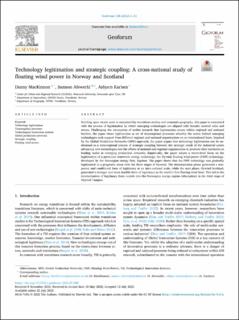| dc.contributor.author | MacKinnon, Danny | |
| dc.contributor.author | Afewerki, Samson | |
| dc.contributor.author | Karlsen, Asbjørn | |
| dc.date.accessioned | 2022-08-25T08:32:04Z | |
| dc.date.available | 2022-08-25T08:32:04Z | |
| dc.date.created | 2022-07-22T10:17:48Z | |
| dc.date.issued | 2022 | |
| dc.identifier.citation | Geoforum. 2022, 135 1-11. | en_US |
| dc.identifier.issn | 0016-7185 | |
| dc.identifier.uri | https://hdl.handle.net/11250/3013455 | |
| dc.description.abstract | Building upon recent work in sustainability transitions studies and economic geography, this paper is concerned with the process of legitimation by which emerging technologies are aligned with broader societal rules and norms. Challenging the assumption of earlier research that legitimation occurs within regional and national borders, the paper views legitimation as set of transregional processes whereby the actors behind emerging technologies seek support from different regional and national organizations on an international basis. Inspired by the Global Production Networks (GPN) approach, the paper argues that technology legitimation can be understood as a trans-regional process of strategic coupling between the strategic needs of the industrial actors advancing new technologies and the efforts of national and regional organizations to promote their territories as leading nodes in emerging production networks. Empirically, the paper adopts a micro-level focus on the legitimation of a particular renewable energy technology: the Hywind floating wind power (FWP) technology, developed by the Norwegian energy firm, Equinor. The paper shows that the FWP technology was gradually legitimated in a pragmatic sense over the three stages of Hywind. The demonstration phase generated a temporary and conditional form of legitimacy at an intra-national scale, while the next phase, Hywind Scotland, generated a stronger and more durable form of legitimacy as the world’s first floating wind farm. This led to the internalisation of legitimacy from outside into the Norwegian energy regime (absorption) in the third stage of Hywind Tampen. | en_US |
| dc.language.iso | eng | en_US |
| dc.publisher | Elsevier | en_US |
| dc.rights | Navngivelse 4.0 Internasjonal | * |
| dc.rights.uri | http://creativecommons.org/licenses/by/4.0/deed.no | * |
| dc.subject | Institusjonell teori | en_US |
| dc.subject | Institutional theory | en_US |
| dc.subject | Energiomstilling | en_US |
| dc.subject | Energy transition | en_US |
| dc.subject | Bærekraftig omstilling | en_US |
| dc.subject | Sustainability transition | en_US |
| dc.subject | Økonomisk geografi | en_US |
| dc.subject | Economic Geography | en_US |
| dc.title | Technology legitimation and strategic coupling: A cross-national study of floating wind power in Norway and Scotland | en_US |
| dc.title.alternative | Technology legitimation and strategic coupling: A cross-national study of floating wind power in Norway and Scotland | en_US |
| dc.type | Peer reviewed | en_US |
| dc.type | Journal article | en_US |
| dc.description.version | publishedVersion | en_US |
| dc.rights.holder | © 2022 The Authors. Published by Elsevier Ltd | en_US |
| dc.subject.nsi | VDP::Samfunnsgeografi: 290 | en_US |
| dc.subject.nsi | VDP::Human geography: 290 | en_US |
| dc.source.pagenumber | 1-11 | en_US |
| dc.source.volume | 135 | en_US |
| dc.source.journal | Geoforum | en_US |
| dc.identifier.doi | 10.1016/j.geoforum.2022.07.008 | |
| dc.identifier.cristin | 2039067 | |
| dc.relation.project | Norges forskningsråd: 321954 | en_US |
| cristin.ispublished | true | |
| cristin.fulltext | original | |
| cristin.qualitycode | 2 | |

